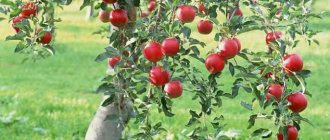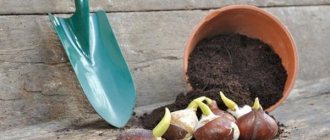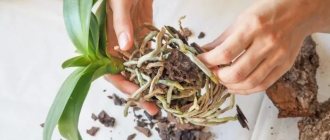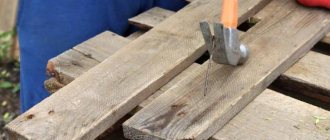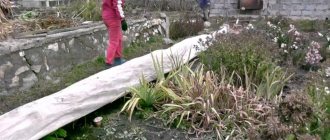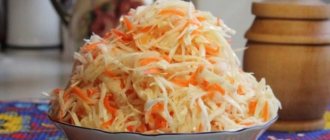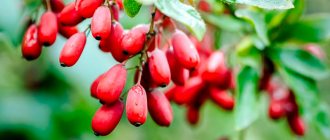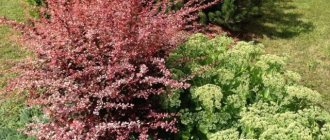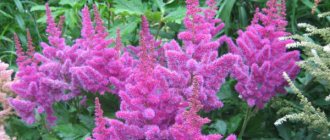Harvest beds Preparing for winter
Author of the article: Igor Ilyin | Updated: 04/13/2019
Many gardeners in our country grow unusually beautiful barberries with healthy berries in their summer cottages. In order for the shrub to overwinter well, when carrying out autumn care, one should take into account such nuances as its intolerance to excessive humidity and the presence of many thorns. Is it necessary to cover barberry for the winter? This is the topic of our article today.
- 1 Features of care
- 2 Video “How to properly cover plants for the winter”
- 3 Preparing for winter
- 4 Proper insulation 4.1 Selection of material
- 4.2 Features of care in different climatic zones
Features of caring for barberry in the fall and preparing for winter - general tips and recommendations
Even the most beautiful plant will look sickly without proper care. Despite its original appearance, barberry does not require special conditions. Caring for a beautiful plant does not take up much free time, which is very valuable in busy times when every minute counts because of the need to pay attention to all the plants in the garden. What does the unpretentious barberry need in the fall in preparation for winter?
Watering. The ornamental shrub is endowed with excellent drought resistance, so the plant needs to be watered only in dry autumn. In order to saturate the barberry with moisture, 10 liters are poured under the bush. water. After watering, the soil is loosened.
Important! Too frequent and abundant watering is dangerous for the shrub due to the appearance of rot on the roots, which quickly destroys the plant.
Feeding. Barberry is very unpretentious to the composition of the soil: feeding during planting is enough for the seedling to exist normally for a whole year. Fertilizers begin to be applied in the second autumn after planting, and the next time the shrub is pampered with a nutrient mixture only after 3-4 years.
According to this scheme, gardeners apply fertilizers to single barberry bushes. As for growing hedges, it is recommended to fertilize such plantings annually once every 2 years, since a group of plants planted nearby quickly sucks nutrients from the soil.
In September, before digging, superphosphate (15 g) and potassium (10 g) are scattered near the plants. Approximately the same amount of fertilizer will be used to fertilize 1 sq.m. plantings. The mentioned mixture can be replaced with compost or humus. Apply 1-2 buckets of the mixture to a young bush, and 3-4 buckets to an adult bush.
Note! It is not recommended to use mineral multicomponent mixtures for autumn feeding of barberry.
Trimming. Cultivating a shrub requires a lot of patience and skill from the gardener, since the shoots of the shrub are covered with sharp thorns. Therefore, to avoid numerous scratches, pruning should be done with thick gardening gloves.
Mulching. Only young bushes 2-3 years old need additional insulation of the rhizome. To protect the seedlings from frost, the tree trunk circle is covered with a layer of dry leaves, peat or spruce branches.
Shelter. Insulation of barberry begins after the average daily temperature has settled at -5-7 C, and the soil has frozen to a depth of 5 cm. The purpose of the shelter is not only to protect the shoots of ornamental shrubs from frost, but also from getting wet.
Video: preparing barberry for winter - autumn pruning and fertilizing
How and with what to fertilize barberry in the fall
Barberry is indeed very unpretentious and can grow in very poor soils. But it's always worth a try. What if the potential of barberry is better revealed if it is fertilized?
In addition, autumn feeding of barberry will strengthen the plant before wintering, and will also help it quickly recover in the spring and begin active growth.
According to the classical scheme, in the autumn, fertilizers are used that contain a lot of phosphorus (responsible for strengthening the root system) and potassium (strengthens the winter hardiness of the shrub and its resistance to fungal diseases). This can be a combination of potassium sulfate and superphosphate, or the use of complex fertilizers such as diammofoska, nitroammofoska or any other fertilizer marked “autumn”.
By the way! If you don’t want to bother, you can simply mulch the barberry circle with humus or compost. This will be an excellent long-lasting supplement.
We invite you to familiarize yourself with the Latest
Pruning in autumn
Shoots covered with thorns are very difficult to trim even with gloves. To protect your hands as much as possible from minor injuries, it is better to perform pruning with a tool with long handles.
Why trim
Pruning is an integral part of growing all shrubs without exception, including barberry.
There are a number of important reasons for autumn pruning of barberry:
- Removing excess branches increases productivity: on neglected shrubs, due to lack of sunlight, few fruits are set or they are completely absent.
- Pruning allows you to give the bush the most intricate shapes.
- As a result of thinning, the barberry crown becomes well ventilated. As a rule, a well-groomed plant is less likely to get sick and be attacked by pests.
Read also: When can you replant a baby orchid?
Agree, in view of the functions that pruning carries, you should not neglect manipulation at all.
When is it better to prune - in spring or autumn?
The timing of barberry pruning is not of key importance: the manipulation will be equally effective in both spring and autumn.
Timing for pruning in autumn
The main condition for starting pruning is the end of fruiting. You can trim the plant before frost sets in. Based on the characteristics of the cultivated variety, autumn pruning of barberry is carried out in September-October.
How to trim correctly - instructions and diagram
Depending on the condition of the barberry, sanitary, formative and rejuvenating pruning is carried out before winter.
The purpose of sanitary pruning is to remove dried, damaged and disease-ridden branches from the bush. To prevent thickening of the crown, such manipulation is recommended to be carried out annually.
Depending on whether the bush is grown as a single specimen or in group plantings, the crown is shaped to obtain the desired shape. Despite the outward “belligerence”, any geometric figure can be cut from a bush - be it a ball, a column or a pyramid.
To maintain shape in the following seasons after pruning, shoots protruding from the crown are shortened to one level. To protect the plant from shock and loss of strength as a result of such a large-scale intervention, formative pruning is extended over 2-3 years.
Barberry has been known to mankind for quite a long time. Its berries contain a large amount of vitamins, improve blood circulation and cardiovascular activity, and a decoction of the root has a beneficial effect on the patient’s condition during pneumonia and fever. However, in gardening the shrub has found a slightly different use. Thanks to its decorative properties, it can become a welcome guest in any garden plot; Thunberg barberry is especially popular. Growing and caring for Thunberg barberry is incredibly simple, so the bush can be recommended for both beginners and experienced gardeners.
Types of shrubs
Thunberg barberry is a deciduous ornamental shrub with arched shoots and thorns. It is undemanding to soil type and resistant to drought and cold.
The plant loves light and can grow in city conditions. Can be grown either singly or in groups. Barberry spines are formed from modified leaves, of which only the core remains.
There are different types of this shrub:
- Barberry Orange Rocket. It is a deciduous shrub with yellow-orange foliage that turns red in autumn. It grows quite slowly and is undemanding to soil fertility. Tolerates frost and drought. Loves a lot of light, but can grow in partial shade, does not grow in stagnant water. The barberry bush bears red fruits. The maximum height of the shrub is 1.50 m. It looks good as part of a hedge or group compositions. It can grow quietly in containers and be used for landscaping loggias and balconies.
- Barberry Red Rocket. A type of deciduous, tall shrub with vertical shoots. It grows quickly and loves fertile soils. The plant also prefers brightly lit areas and is resistant to cold and drought. It is used in vertical flower beds and hedges, and looks good in combination with shrubs and trees. The foliage has a red-brown color scheme that changes to purple in the fall. The plant bears fruit with light scarlet berries. Grows up to three meters.
- Harlequin. A variegated shrub that does not require special soil for planting. It is resistant to cold, but in a snowless winter it may lose some of its shoots. Not susceptible to diseases and pest attacks. Adapts well to city conditions. The plant has a spreading, rounded crown. The leaves are burgundy with patches of white and pink, turning red in the fall. The flowers have a yellow-red tone. The fruits of barberry stand out with their bright red appearance. The height of the bush does not exceed 1.20 m.
- Admiration. This is a dwarf shrub with a spherical crown shape. It has leaves of orange and red colors with a yellowish border. In autumn it turns yellow and red. Barberry begins to bloom in May and bears juicy red fruits. Can grow up to 60 cm in height. The small size allows the plant to be used in flower beds, rock gardens and borders.
- Aurea. The plant has a rounded crown of a golden hue, which turns yellow-orange in the fall. Bears bright red fruits and grows slowly. It reaches a height of 80 cm and blooms in May. Barberry is suitable for any soil and tolerates cold well. Suitable for group and single compositions, small decorations and borders.
We suggest you familiarize yourself with How and when to plant gladiolus bulbs in open ground
Mimosa flower: growing and care at home
Decorative properties of Thunberg barberry
There are many varieties of barberry, all of them differ in different shrub structure, intensity of foliage color and shape of inflorescences. Tall shrubs will look good in single plantings and as a hedge. Dwarf specimens, not exceeding 35 cm in height, can be placed on a rocky hill or decorated with a border.
Magnificent Thunberg barberry - cultivation and care are practically no different from other species. This is a compact bush no more than one and a half meters high, ideal for decorating hedges and zoning a site. The leaves are yellow-red, it bears fruit profusely, but the berries are not eaten. Barberry looks most impressive in autumn, when the foliage turns scarlet, ruby or dark crimson. The following varieties are especially popular:
Description of barberry
Barberry is a deciduous shrub that is known for its medicinal properties and extraordinary decorative properties. There are about 175 species of this plant. Barberry is distributed on all continents, except perhaps Antarctica. The plant loves mainly mountainous areas. But it also feels good in gardens, and is found growing wild in Europe, the Caucasus, Crimea, and Persia. This delicate ornamental shrub will decorate any area and create a unique charm in your garden. Various types of barberry are known - evergreen shrubs, semi-deciduous (which only partially shed their leaves) and completely deciduous. The plant has ribbed, straight shoots and extremely attractive foliage. It has very fragrant and decorative flowers, which in the fall turn into bright red, sour-tasting berries.
Choosing a site for growing Thunberg barberry
The shrub prefers well-lit and open areas, however, it should be protected from gusts of cold wind. It will also grow in partial shade, but under such conditions the attractiveness of its appearance will noticeably suffer - the foliage will become less bright.
Before planting Thunberg barberry, you should study the composition of the soil on the site. The shrub does not have any special requirements for soil, but it will grow much more willingly on a loose, nutritious substrate with a neutral reaction. Too dense soils are diluted with peat and humus before planting; areas with high acidity require the addition of slaked lime (400 g per 1 planting hole is enough). In order to make the soil more fertile, it is necessary to add complex mineral fertilizer, and calculate the dosage according to the instructions.
Common barberry
Can be found in the forest-steppe of Russia, in the Crimea, in the Caucasus. It is approximately 2.5 meters high with brownish-yellow stems covered with 2-centimeter spines. Its foliage is dark green and forms small tufts. It blooms in the first days of summer with tassels of yellow, shining flowers that emit an interesting scent.
With the onset of autumn, the foliage begins to turn yellow. The berries of this type, unlike Thunberg barberry, are completely suitable for food - refreshing, sour in taste. Common barberry is characterized by good resistance to winter cold, drought and dust, as well as low soil requirements (light and limed soil is preferred).
Despite the fact that a shaded area is quite suitable for the shrub, it will bear fruit abundantly only in good light conditions. Not afraid of pruning. The main disadvantage of this species is considered to be susceptibility to fungal attack, which most often manifests itself if the summer is damp and cold.
Atropurpurea, with red foliage and up to 2 meters in height, is considered a very popular variety of barberry in floriculture. The flowers of this variety are yellowish-orange and the berries are dark red.
Planting a barberry seedling
Barberry Thunberg - planting can be carried out throughout the spring-summer season. Planting time depends on the type of seedling purchased. Instances located in a shipping container can be planted both in spring and summer without disturbing the earthen coma. Plants in bags (with bare roots) are rooted in early spring, before the start of the growing season. It is not recommended to plant Thunberg barberry in the fall, as this species adapts slowly and may die with the onset of cold weather.
The planting hole should be medium in size, approximately 40x40x40 cm. Spreading bushes are planted at a distance of about one and a half meters from each other. If barberry will be used as a hedge, then it is wiser to dig a trench and place seedlings in it at the rate of 2 specimens per 1 linear meter.
Read also: Brick barbecue project
Planting Thunberg barberry will not cause much trouble for the gardener. A layer of drainage is poured into the prepared hole; the excavated soil, if necessary, is mixed with a nutrient substrate and fertilizers and partially poured into the hole. Next, place the seedling, sprinkle it with the remaining soil, compact the soil and water it with water.
Benefits of barberry
The unpretentious red barberry has won the hearts of many of its fans. And for good reason. The small red barberry berry contains many useful substances. Ripe fruits contain carotenoids, fructose and glucose, organic acids, and pectin. All parts of the plant contain the alkaloid berberine. In the bark of the bush, the amount of alkaloids reaches 0.46 - 0.53%.
Even in ancient Greece, they knew the healing properties of barberry to purify the blood. And the sages of Tibet believe that red berries prolong youth.
An infusion of ripened fruits has long been used in the treatment of colds and the removal of toxins. Red berries will also be useful in the treatment of liver diseases, inflammation of the bladder, and kidneys. Barberry juice has no less healing properties - it perfectly removes toxins from the body and has an anti-inflammatory effect.
Barberry is one of those rare plants, all parts of which are beneficial to health. The most studied healing properties of barberry are:
- Its ripe berries are not only tasty and are successfully used as a seasoning for food, but also very healthy, as they contain large amounts of ascorbic, malic, citric, tartaric acid and vitamin K.
- Juice from berries is a valuable vitamin supplement.
- The unripe fruits are known to contain the alkaloid berberine, which is used in the treatment of liver and gallbladder diseases.
- Tincture of barberry leaves and roots is used to stop uterine bleeding.
- Root extracts are used to normalize digestion, they reduce inflammation of the mucous membranes; a decoction of barberry roots can be used to rinse your mouth for gum inflammation.
Features of caring for Thunberg barberry
Caring for decorative Thunberg barberry is not much different from growing other species. Just like most garden plants, shrubs need regular watering, weeding and additional nutrition.
Watering and fertilizing
The shrub is drought-resistant and does not tolerate excessive waterlogging of the soil, so watering should be moderate. Experienced gardeners recommend irrigating the soil once a week, however, if the weather is rainy and cool, then the procedure should be skipped. Use warm water, previously settled in a barrel. Water the shrub strictly at the root using a watering can with a “spout.”
After planting Thunberg barberry, the ground is mulched with peat, humus, straw or wood shavings. This not only prevents the growth of weeds, but also allows you to maintain an optimal level of soil temperature. Periodically, the layer of mulch needs to be renewed, and the soil around the bush needs to be loosened with a garden trowel.
If a sufficient amount of fertilizer was added to the soil during planting of the seedling, then fertilizing begins from the second year of life. In the spring, with the beginning of the growth of young shoots, special attention should be paid to nitrogen, which stimulates the growth of green mass. To do this, you can prepare a urea solution at the rate of 25 g of the substance per 10–12 liters of water. In the future, you should use a complex mineral fertilizer containing 3 main elements: nitrogen, phosphorus and potassium. In total, 2-3 feedings are enough per season.
Pruning barberry Thunberg
Pruning is an integral part of care when growing Thunberg barberry. The type of pruning depends on the type of shrub and its role in landscape design. Many gardeners prefer to give their plants a decorative shape, such as a ball. In this case, pruning is carried out in the spring; if necessary, the shape is adjusted throughout the summer period. Specimens decorating an area as a hedge also require close attention; as a rule, they are cut at the beginning of summer and at the end. Low-growing shrubs do not need pruning. Even if the natural shape of the bush completely suits the gardener, you should not refuse sanitary pruning. Timely removal of dried and broken branches stimulates more luxuriant and longer flowering.
Preparing Thunberg barberry for winter
Unlike other species, Thunberg barberry is less winter-hardy. After leaf fall, the bush is prepared for winter. The garbage and old layer of mulch are raked into a pile and removed. After this, the plant is hilled up, the soil is mulched with peat, humus or compost, a layer of 10 cm is enough. Young specimens aged 1 to 5 years are additionally covered. Most often, gardeners use the following technique. The branches are tied together with twine and a cap made of burlap or any non-woven material (lutrasil, agrofibre) folded in 3-4 layers is put on the bush. Additionally, barberry can be covered with spruce branches.
Diseases and pests of barberry Thunberg
Often, when growing Thunberg barberry, care involves fighting various diseases and pests. Most often, the shrub is affected by powdery mildew, a dangerous fungal disease that, if neglected, can destroy most of the garden, as well as rust. For treatment, you can use modern chemicals or a solution of colloidal sulfur (1%).
The most common pests are barberry aphids and barberry sawflies. You can easily get rid of the sawfly by treating the bushes with a chlorophos solution (1% or 3%). When fighting aphids, a solution of laundry soap prepared at the rate of 150 g per 5 liters of clean water is effective.
Barberry ottawa
Hybrid of Thunberg barberry and common atropurpurea. It has a height of up to 2 meters. The foliage, dark purple in summer, turns red in autumn. The flowers, painted reddish-yellow, form clusters of 8-10 pieces, blooming in the last days of May. The berries are dark red. In addition to the fact that this species is unpretentious and frost-resistant, it also copes well with pruning, drought and is practically not susceptible to disease.
Amur barberry is common in rocky areas of China, Japan and Primorye. Outwardly, it is very similar to the common barberry, but reaches as much as 3.5 meters in height, with grayish-yellow stems dotted with 2-centimeter spines. The foliage is relatively large (up to 8 cm in length), shiny, has teeth at the edges, bright green in spring, yellow or red in autumn.
Flowering occurs at the end of May and is characterized by the appearance of elongated tassel-shaped inflorescences up to 10 cm in length, formed from 10-25 yellow aromatic flowers. The sour berries of this type can also be eaten, they are red in color, up to 1 cm in diameter, and can be stored on the bush for a long time. It is not picky about the soil, resistant to winter, drought and pests, especially powdery mildew.
Rules for preparing for winter
Even the most beautiful ornamental plant loses its attractiveness if wintering is not organized correctly. Despite its high winter hardiness, barberry suffers from sudden changes in temperature conditions. So, a snowy and frosty winter is not a hindrance for this ornamental crop. But sudden thaws in the middle of winter, which are followed by severe frosts, can lead to damage to thin branches and icing of the root system. To prevent freezing of an ornamental shrub, you need to know how to properly prepare the plant for the upcoming cold weather.
Read also: Assembling an accordion door step by step instructions
Autumn preparation of barberry for winter consists of several simple procedures:
- Watering. Barberry is characterized by high drought resistance. The bush is watered only if the autumn turns out to be stingy in terms of precipitation.
- Fertilizer application. Autumn fertilizing involves adding organic and mineral fertilizers to the soil. However, it is not recommended to use ready-made mixtures that contain nitrogen-containing substances.
- Rejuvenating crown pruning. Removing old shoots that have been broken by the wind or damaged by insects and rodents is best done with protective gloves, since sharp thorns on the branches can leave scratches on your hands.
- Soil preparation. Digging up the soil allows you to create an air cushion and saturate the soil with oxygen. Mulching protects against excess moisture and icing of the root system due to unexpected temperature changes.
The preparation and features of the technology for covering barberry for the winter depend on the varietal characteristics and climatic characteristics of the region where the shrub grows.
Using barberry thunberg in landscape design
Each variety of barberry differs in some way from another type of shrub - in height, crown shape, color of leaves, flowers and even branches. All these differences give gardeners and landscape designers an extraordinary flight of fancy. Barberry can be used in flower beds, in mixborders, and in alpine gardens.
Thanks to the wide palette of colors, barberry can be combined in any way you like, both in rock gardens and in mixed compositions, creating masterpieces of design art. Multi-colored barberry will look very beautiful against the background of decorative needles. In general, all varieties get along well with conifers and flowers. In addition to purely decorative purposes, you can plant barberries on slopes to strengthen the soil.
Interesting! Tibetan monks use barberry fruits in cooking. They revere the plant as a source of youth and strength.
What plants need to be covered
The feasibility of insulating barberry for the winter depends on the varietal characteristics of the crop being grown. Most gardeners prefer to cultivate frost-resistant crops in their summer cottages. Thus, the varieties Obyknovenny, Ottawa, Thunberg and other types of barberry, which are native to Canada, are very popular among summer residents of central Russia. Barberry varieties Orange Rocket, Red Rocket, Harlequin, Admiration, Maria, Atropurpurea, Bagatelle and Rose Glow are highly winter hardy and can be grown even in northern regions.
Varieties Red Pillar, Juliana, Green Carpen, Golden Rocket and Aurea are less frost-resistant: in severe frosts, young shoots freeze. Columnar shrubs and barberry hybrids require more careful preparation for winter and reliable shelter.
Why do you need insulation?
The technique of covering ornamental crops for the winter is based on the varietal qualities of the cultivated plants.
Thus, most barberry varieties of domestic and Canadian selections - Thunberg, Ottawa, Obyknovenny, etc. - are characterized by excellent hardiness and high frost resistance. Suitable varieties for the northern region are Rose Glow, Harlequin, Admiration, Red Rocket, Orange Rocket, Bagatelle, Atropurpurea and Maria. The varieties Golden Rocket, Aurea, Juliana, Green Carpen and Red Pillar are considered less winter-hardy and require insulation for the winter. Keep in mind that young shrubs and ornamental crops weakened after transplantation or disease require a dense covering layer for the winter.
Insulation options
Most ornamental plants, including barberry shrubs, are frost-resistant crops that do not require additional shelter for the winter. According to the recommendations of experienced gardeners, only young plants and the root collar of bushes aged 3 years and older need to be well covered. At the stage of preparing the bush for the upcoming cold weather, the root collar should be cleaned of inert peat and covered with dry chernozem. Mulching the soil in the tree trunk circle with sawdust, straw, dry soil, fallen leaves and small coniferous branches protects the plant during temperature changes.
It is necessary to insulate the above-ground part of the bush only if the plant has recently been transplanted into open ground. A barberry bush that has not had time to get stronger may not be able to cope with the first frosts. To protect the plant from the cold, it is recommended to collect all the shoots in a loose bunch and cover them with covering material. As insulation for the winter, you can use burlap, agrofibre, non-woven material, lutrasil or ordinary white polypropylene bags.
The height of the mulch layer should not be more than 10–12 cm. Too high a cover can lead to the opposite consequences: the root collar of the barberry will begin to rot and rot. It is also not recommended to compact the mulch layer, since the absence of air spaces impedes air circulation.
Features of the technology for covering ornamental plants for the winter may differ in different regions. In the Volga region, Moscow region and other regions of Russia with a warm, temperate climate, barberries are mulched and the root collar is insulated.
In Siberia and the Urals, the bush is covered with dense non-woven material. Please note that the covering material must allow air to pass through, otherwise a greenhouse effect will form inside. Excess moisture on the inner walls of the covering material can cause the bush to rot. In severe frosts, you need to cover the plant with a wooden box or metal mesh, inside which pine spruce branches are placed and dry earth or sand is filled.
Covering the barberry
In the process of preparing barberry for the change of season, the question arises whether it is necessary to cover the shrubs for the winter. The need to cover barberry depends on its variety. Many species tolerate frosts down to -10 ° C, while others freeze even at not too low temperatures. Therefore, when covering, you should take into account the type of shrub, otherwise it will freeze or dry out.
Varieties such as Thunberg barberry and its varieties (Orange Rocket, Red Rocket, Harlequin, Admiration), Common and shrubs from Canada are resistant to cold weather and are able to survive wintering without shelter, especially if there is a lot of snow. Cold-resistant varieties can be covered by covering them with snow yourself. For the Thunberg barberry species, the need for shelter disappears after it reaches the age of 4-5 years from the moment of planting.
If the winter is especially cold, the tops of the shoots may freeze, but with the onset of spring they will recover and grow again quite quickly.
Varieties such as Red Pillar, Juliana, Green Carpen, Golden Rocket, Aurea, hybrids and columnar shrubs are not cold-resistant and require more careful care and shelter for the winter.
Whether it is necessary to cover barberry for the winter also depends on the age of the plant. If the bush has not reached 3 years old, it should be covered completely and tightly. For shrubs older than 3 years, protection from the cold of the root collar is sufficient. Barberries whose bushes are not yet 5 years old should be covered with spruce branches, especially if the species is evergreen.
The neck is cleared of peat if barberry was grown in it, and the freed space is filled with dry soil. Around the trunk, black soil is poured into a mound 10-12 cm high. This allows not only to protect the plant from frost, but also to soften temperature fluctuations for it during sudden thaws and frosts.
For this purpose, instead of soil, you can use sawdust, straw, fallen leaves or small branches of pine needles. But the layer should not be too dense and not exceed 12 cm, otherwise the neck will begin to overheat and rot, and air will not be able to circulate freely in the overly compacted layer.
We recommend that you familiarize yourself with Gooseberry Mashenka
The above-ground part is strengthened when the plant is young, belongs to one of the heat-loving species, or has recently been transplanted. To do this, the branches are collected in a bundle and covered with material: burlap, polypropylene bags, agrofibre. In addition, geotextile and jute fabrics, spunbond, lutrasil, as well as “Obernit” and “Luck 60” are used.
Afterwards, the covered bundle is secured with a rope so that the structure does not fall apart under gusts of wind or as a result of snowfall. The rope should be tied loosely to avoid tugging.
You can use a frame made of wooden slats installed around the perimeter of the bush. Pull the material over it and secure it, fill the space between the support and the shelter with straw or wood shavings. Instead of slats, metal mesh is also used. A cylinder is constructed from it, the height of which should be 10 cm greater than the bush.
The barberry cover should be so that there is a hole in the ground. Air will flow through it to the bottom of the shoots.
The method of protecting barberry from the cold in winter also depends on the region in which it grows. In regions of Russia with warm and temperate climates, plants only mulch and strengthen the root collar.
In areas with a colder climate, in Siberia and the Urals, barberry is mulched with a higher layer, reaching 20-25 cm. Afterwards, the shrub is additionally covered on top. The branches can be kept upright or bent to the ground. The canvas that covers the barberry should be fixed by pressing it to the ground with pegs, wooden slats, beams, bricks and any stones. This way it won't be blown away by gusts of wind.
It is important that the material with which the plant is covered allows air to pass through, otherwise a greenhouse effect will occur and the bush will begin to rot. If frosts intensify, the barberry can be additionally covered with a wooden box, inside which pine spruce branches, dry soil or sand can be placed.
When is it better to plant barberry: autumn or spring
For barberry, both spring and autumn planting is possible. In spring, planting should be done before the buds on the seedling begin to swell. At the same time, you need to make sure that the danger of return frosts has passed and temperatures have settled above zero. Later planting will significantly increase the adaptation period, since the young plant will strive not only to develop the root system, but also to increase green mass.
In autumn, it is possible to plant both Thunberg barberry and ordinary barberry. At the same time, it is important that the planted plant has enough time to adapt to the new place and have time to take root before the onset of frost. If the required deadlines are met, the planted bush will develop its root system and be well prepared for the first wintering.
Important! Seedlings in containers or pots with a closed root system can be planted in the summer, protecting them from direct sunlight for the first time.
Powdery mildew on barberry: is it necessary to spray in the fall against the disease?
At the end of summer (August) - beginning of autumn (September), if the weather is too rainy (which is especially true in dense plantings or in a shady place), barberry can pick up powdery mildew.
Of course, you can carry out an autumn eradication treatment of the bush with the same copper sulfate or Bordeaux mixture, but this is not necessary.
In any case, next spring everything will be fine with your barberry.
However, as a rule, most varieties, especially Thunberg barberry, are resistant to all diseases, including powdery mildew and rust.
Diseases and pests
One of the most dangerous pests of barberry is the barberry aphid. The affected leaves of the plant wrinkle and dry out. The insect can be seen on the underside of the leaf; the body of the pest is reddish-yellow. An increase in the colony of insects harms the plant: the leaves curl and fall off, the shoots do not lay next year’s flower buds and become bent. In the spring, spray barberry with a solution of laundry soap or tobacco infusion.
The flower moth feeds on barberry fruits. Treatment with fufanon or decis will help here.
Fungal diseases are much more dangerous to plant health. They are more difficult to fight, and barberry is affected by them more often than by insects.
- Powdery mildew. This disease is caused by a unique fungus that specializes only in barberries. If you notice a whitish coating on the shoots and leaves at the beginning of summer, this is the mycelium of the fungus, which will ripen by autumn and spread even more in the spring. It is necessary to spray the plant with a preparation containing sulfur. The leaves are sprayed on both sides. The procedure is carried out twice: at the time of bud break and after flowering. In case of severe damage, apply again in the fall, after harvesting. It is better to remove and burn shoots that are severely damaged.
Planting Barberry Thunberg and caring for the shrub will not cause any trouble, but the aesthetic pleasure from its beauty in your garden will exceed all expectations.
Pruning barberry in the fall: you need to trim it for the winter
In the autumn, barberry only requires sanitary pruning. Namely, you need to remove all broken, dry and diseased branches.
In general, in the fall you can trim your barberry, i.e. give it rejuvenating (remove thickening, weak and extra shoots) and formative pruning (cut the remaining branches to fit = give the plant the desired shape), but only if the following 2 conditions are met:
- If you already have a mature 5-10 year old plant.
- Do this in August and the first half of September (1.5-2 months before the onset of frost) so that the bush can have time to recover before wintering.
Advice! And it is very advisable after such early autumn pruning to spray the plant with growth stimulants (Epin or Zircon).
Unfortunately, barberry is known for its thorniness, so use long-handled pruning shears to trim it.
The main (formative) pruning of barberry is carried out in the spring, always before the start of sap flow (bud opening), i.e. approximately in the second half of March-April.
Remember! Barberry responds very well to pruning: new shoots and leaves appear in just 2-3 weeks.
How to transplant barberry to a new place in the fall
In some cases, an adult barberry bush may need to be transplanted to another location. For example, if as a result of the construction of a new structure, the place of its constant growth is in the shade. However, it must be remembered that the older the barberry is, the worse it tolerates transplantation.
Transplanting an adult barberry bush to a new location is possible in spring or autumn at the same time as planting seedlings. Before this event, it is advisable to prune to reduce the consumption of nutrients, since during replanting some of the roots will be cut off or damaged. It is better to prepare the pit for transplanting 2-3 weeks before the day of the event, and the day before it must be spilled with water. The transplanted bush is also watered abundantly the day before transplantation.
Barberry transplantation in the fall is best done on a cloudy day. The bush is dug along the projection of the crown, cutting off the roots, then carefully removed from the ground along with a lump of soil on the roots. The most convenient way to transport a plant with thorny shoots to a new place is on a piece of tarpaulin. Before planting, it is advisable to soak the soil on the roots with Epin’s solution, and sprinkle the exposed roots with Kornevin or another growth stimulant. After this, the shrub is installed in the planting hole, and the resulting voids are filled with soil. Then the root zone is watered abundantly.
Landing
Barberry is undemanding to its growing location. It can grow well in open areas and in partial shade. However, varieties with purple leaves may lose their decorative value in the shade.
Barberry prefers to grow in soils with neutral acidity; wood ash or lime must be added to soils with high acidity. The most important thing for barberry is the absence of moisture stagnation.
Barberry is planted in early spring, before buds begin to bloom. If the bushes are planted singly, the distance between them should be from 1.5 to 2 meters. The planting hole for one plant is about 50 x 50 cm and 35 cm deep. When laying a hedge, two seedlings are planted per meter. It is better to dig a trench for planting the hedge. To improve the respiration of the root ball, sprinkle the bottom with sand and fill the hole with nutritious soil with the addition of humus and wood ash. Water and compact the soil.
The tree trunk circle is mulched with humus, leaves or any organic material. In order for the plant to take root well, cut off the above-ground part, leaving 3 to 5 buds. Watering barberry is necessary when planting and once every 10 days until the seedling is accepted.
Barberry seedlings purchased in a container can be planted at any time except winter - they take root well, since the root system is not damaged.
Advice. Use only fully ripened barberries; unripe ones can be poisonous.
Barberry propagation
Barberry is propagated by different methods: seeds, cuttings, layering and dividing the bush. Each of these methods is convenient in its own way, choose the most suitable one.
Propagation by seeds. Select ripe berries, separate the seeds from the pulp, disinfect them in a weak solution of potassium permanganate and dry. The seeds are sown in the seedling to a depth of 1 cm. In the spring, the young seedlings are thinned out so that there is a distance of about 3 cm between the sprouts. Two-year-old seedlings are planted in a permanent place. In a couple of years, the young bushes will bear the first berries. In order to sow seeds in spring, they must be stratified for a long time at a temperature of 2 to 5 degrees.
Propagation by cuttings . For this method you will need a greenhouse or school. Cuttings are harvested in June. It is better to do this early in the morning, before the heat sets in. The leaves are removed from the cuttings, leaving only at the top, shortened by half. Place the cuttings in a bucket with root solution for several hours to stimulate root formation. The cuttings are planted in a schoolhouse in fertile, moist soil. For the first two weeks, carefully monitor soil moisture and timely ventilation. As with the first method, cuttings are planted in a permanent place after two years.
Reproduction by layering. In early spring, select the strongest shoot, place it in an earthen ditch and pin it. The end of the shoot should be above the ground. The part that you will dig in can be lightly scratched for faster root formation. In the fall, the finished seedling can be transplanted to a permanent location.
By dividing the bush, mainly low-growing varieties of Thunberg barberry are propagated. To do this, choose bushes 3 to 5 years old, which branch from ground level. In early spring, the bush is completely dug up and divided with a saw. Try to injure the root system as little as possible. Treat the sections with a weak solution of manganese or sprinkle with charcoal. Plant the divisions.

